
In collaboration with Prof. Kang Wang’s group at UCLA, Cheng, Yang and collaborators reported observation of unidirectional spin Hall magnetoresistance in Pt/α-Fe2O3 bilayers grown on α-Fe2O3 (0001). Spin Hall magnetoresistance (SMR) has been extensively used to probe magnetic and spin configurations in both ferromagnetic and antiferromagnetic heterostructures in the past decade. Recently, a new type of magnetoresistance, unidirectional SMR (USMR), has been observed in in HM/FM heterostructures. Compared with conventional SMR, the USMR is a non-linear magnetoresistance where the measured voltage depends quadratically on the applied electrical current. The magnitude of USMR unidirectionally depends on the angle between spin polarization and the FM magnetization, providing a more precise way to probe the spin state of the FM. The USMR in Pt/α-Fe2O3 bilayers has been observed through systematic field and temperature dependent measurements, which confirm the magnonic origin of the USMR. The appearance of USMR in Pt/α-Fe2O3 is driven by the imbalance of creation and annihilation of antiferromagnetic magnons by spin-orbit torque due to the thermal random field. Theoretical modeling reveals that the USMR in Pt/hematite, unlike its ferromagnetic counterpart, is determined by the antiferromagnetic magnon number with an apparent non-monotonic field dependence. The theoretical result can well explain the experimental observation, paving new ways for the highly sensitive detection of AFM spin states. This finding extends the generality of the USMR which pave the ways for the highly sensitive detection of AFM spin state.
This article was published in Physical Review Letters and is available here.



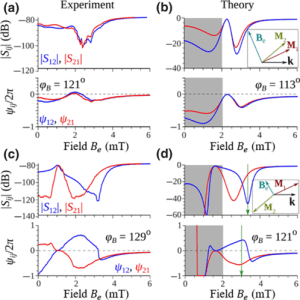
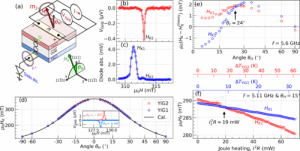

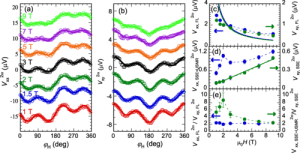

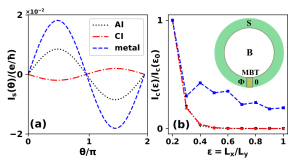 The antiferromagnetic topological insulator MnBi2Te4 features lots of exotic physical phenomena at low temperatures, forging a new direction that joins topological materials with magnetic materials. Yet a missing ingredient in the grand inquiry into antiferromagnetic topological insulators is how the antiferromagnetic behavior can manifest in the quantum tunneling, which has wide applications in quantum computing and related applications. To this end, PI-Cheng’s group studied the transport properties of a Josephson junction consisting of two identical s-wave superconductors separated by an even-layer MnBi2Te4. By numerically calculating the supercurrent in the presence of a perpendicular magnetic field, PI-Cheng found that the quantum interference in such a device setup exhibits distinct patterns when the MnBi2Te4 is in different magnetic states. In its antiferromagnetic state, the MnBi2Te4 is an axion insulator supporting an extended “hinge” supercurrent, which leads to a sinusoidal interference pattern decaying with the field strength. In the ferromagnetic state, on the other hand, the MnBi2Te4 is a Chern insulator and the unbalanced chiral supercurrents on opposite edges give rise to a highly asymmetric interference pattern. If the MnBi2Te4 turns into a metal as the Fermi level is tuned into the conduction band, the interference exhibits a Fraunhofer pattern due to the uniformly distributed bulk supercurrent. This work unravels a strong indicator to identify different phases in MnBi2Te4 and can be verified directly by experiments.
The antiferromagnetic topological insulator MnBi2Te4 features lots of exotic physical phenomena at low temperatures, forging a new direction that joins topological materials with magnetic materials. Yet a missing ingredient in the grand inquiry into antiferromagnetic topological insulators is how the antiferromagnetic behavior can manifest in the quantum tunneling, which has wide applications in quantum computing and related applications. To this end, PI-Cheng’s group studied the transport properties of a Josephson junction consisting of two identical s-wave superconductors separated by an even-layer MnBi2Te4. By numerically calculating the supercurrent in the presence of a perpendicular magnetic field, PI-Cheng found that the quantum interference in such a device setup exhibits distinct patterns when the MnBi2Te4 is in different magnetic states. In its antiferromagnetic state, the MnBi2Te4 is an axion insulator supporting an extended “hinge” supercurrent, which leads to a sinusoidal interference pattern decaying with the field strength. In the ferromagnetic state, on the other hand, the MnBi2Te4 is a Chern insulator and the unbalanced chiral supercurrents on opposite edges give rise to a highly asymmetric interference pattern. If the MnBi2Te4 turns into a metal as the Fermi level is tuned into the conduction band, the interference exhibits a Fraunhofer pattern due to the uniformly distributed bulk supercurrent. This work unravels a strong indicator to identify different phases in MnBi2Te4 and can be verified directly by experiments. Robust spin injection and detection in antiferromagnetic thin films is a prerequisite for the exploration of antiferromagnetic spin dynamics and the development of nanoscale antiferromagnet-based spintronic devices. Existing studies have shown spin injection and detection in antiferromagnet-nonmagnetic metal bilayers; however, spin injection in these systems has been found effective at cryogenic temperatures only. A recent experiment done by Prof. Igor Barsukov at UC-Riverside experimentally demonstrated sizable interfacial spin transport in a hybrid antiferromagnet-ferromagnet system, consisting of Cr2O3 and permalloy, which remains robust up to the room temperature. In collaboration with Prof. Igor Barsukov, PI-Cheng well explained the experimental data using a spin diffusion model and find evidence for the important role of interfacial magnon pumping in the signal generation. The experimental results, along with the intuitive theoretical model, bridge spin-orbitronic phenomena of ferromagnetic metals with antiferromagnetic spintronics and demonstrate an advancement toward the realization of room temperature antiferromagnetic spintronics devices.
Robust spin injection and detection in antiferromagnetic thin films is a prerequisite for the exploration of antiferromagnetic spin dynamics and the development of nanoscale antiferromagnet-based spintronic devices. Existing studies have shown spin injection and detection in antiferromagnet-nonmagnetic metal bilayers; however, spin injection in these systems has been found effective at cryogenic temperatures only. A recent experiment done by Prof. Igor Barsukov at UC-Riverside experimentally demonstrated sizable interfacial spin transport in a hybrid antiferromagnet-ferromagnet system, consisting of Cr2O3 and permalloy, which remains robust up to the room temperature. In collaboration with Prof. Igor Barsukov, PI-Cheng well explained the experimental data using a spin diffusion model and find evidence for the important role of interfacial magnon pumping in the signal generation. The experimental results, along with the intuitive theoretical model, bridge spin-orbitronic phenomena of ferromagnetic metals with antiferromagnetic spintronics and demonstrate an advancement toward the realization of room temperature antiferromagnetic spintronics devices.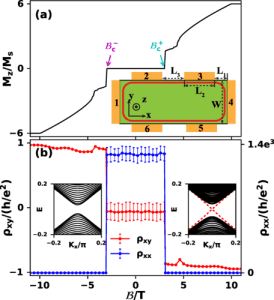 The intrinsic magnetic topological insulator MnBi2Te4 is believed to be an axion insulator in its antiferromagnetic ground state (with even number of septuple layers). However, direct identification of axion insulators remains experimentally elusive because the observed vanishing Hall resistance, while indicating the onset of the axion field, is inadequate to distinguish the system from a trivial normal insulator. Using numerical Green’s functions, PI-Cheng’s group theoretically demonstrated the quantized magnetoelectric current in a tunnel junction of atomically thin MnBi2Te4 sandwiched between two metallic contacts, which is a smoking-gun signal that unambiguously confirms antiferromagnetic MnBi2Te4 as an axion insulator.
The intrinsic magnetic topological insulator MnBi2Te4 is believed to be an axion insulator in its antiferromagnetic ground state (with even number of septuple layers). However, direct identification of axion insulators remains experimentally elusive because the observed vanishing Hall resistance, while indicating the onset of the axion field, is inadequate to distinguish the system from a trivial normal insulator. Using numerical Green’s functions, PI-Cheng’s group theoretically demonstrated the quantized magnetoelectric current in a tunnel junction of atomically thin MnBi2Te4 sandwiched between two metallic contacts, which is a smoking-gun signal that unambiguously confirms antiferromagnetic MnBi2Te4 as an axion insulator.